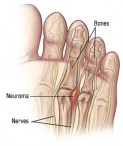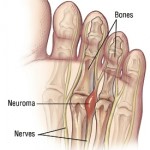A Morton’s neuroma is swelling in the nerve or inflammation around the nerve at the base of the toe. Pain occurs in the two adjacent toes. The nerve affected by Morton’s neuroma runs from the foot surface to the toes. Due to the pressures of walking, standing and wearing shoes, severe, intermittent pain can occur in the ball of the foot. Some patients also experience numbness in the toes or sharp, sudden pains.
What causes Neuroma?
- Chronic foot injuries.
- Biomechanical problems, such as bunions or foot pronation.
- Genetics, including inheriting flat feet.
- High-heeled shoes with pointed toe boxes.
- Ill-fitting shoes.
- Rheumatoid arthritis or gout.
- Repetitive trauma, such as that caused by jogging.
- Pregnancy.
Symptoms of Morton’s neuroma include:
- Pain in the ball of the foot.
- Pain and/or numbness between the toes.
- Clicking sensation when walking.
- Sharp, tingling pain.
- Pain after jogging.
- Pain relief after removing one’s shoes.
How is this treated?
Non-surgical
- Wearing shoes with a roomy toe box.
- Treat biomechanical conditions, such as bunions.
- Rest the foot and apply ice after activity.
- Take anti-inflammatory medications.
- Wear a foam pad under the toes or between the toes.
- Obtain an injection of xylocaine and cortisone in the affected area in an attempt to clearly diagnose the condition and also reduce the symptoms by decreasing the inflammation in the area.
- Wear shoe inserts.
If the above treatments do not relieve the pain, your doctor may recommend surgery.
What are the risks of treatment?
Surgery for Morton’s neuroma consists of removal of the affected nerve prior to its branching to the toes. Risks of surgery include infection, toe stiffness, or a recurrent neuroma. Numbness will result since the nerve is removed. However, over time, numbness typically becomes negligible.
How do I prepare for surgery?
Always ask your surgeon for complete pre-operative preparation instructions. Typically, these may include:
- Complete any pre-operative tests or lab work prescribed by your doctor.
- Arrange to have someone drive you home from the hospital.
- Refrain from taking aspirin and non-steroidal anti-inflammatory medications (NSAIDs) one week prior to surgery.
- Call the appropriate surgery center to verify your appointment time.
- Refrain from eating or drinking anything after midnight the night before surgery.
What do I need to do the day of surgery?
- If you currently take any medications, take them the day of your surgery with just a sip of water.
- Refrain from taking diabetic pills or insulin.
- Do not wear any jewelry, body piercing, makeup, nail polish, hairpins or contacts.
- Leave valuables and money at home.
- Wear loose-fitting, comfortable clothing.
What happens during surgery?
Your foot will be initialized in the preoperative area by someone from the surgical team. In the operating room, you will be met by a nursing team and the anesthesia team. You have several anesthetic options:
- General: Completely asleep and breathing through a tube
- Epidural/Spinal: Numb from the waist down, or
- Local: Numbing medicine just above the surgical site
Epidural/Spinal and Local are usually combined with sedative medication so you can rest comfortably during the procedure. Once you are anesthetized, the surgery is initiated.
Surgery is typically done on an outpatient basis under local anesthesia. The doctor makes an incision on the top of the foot to remove the nerve. He then sutures the incision with stitches.
What happens after surgery?
Because the procedure involves removing the nerve and neuroma, permanent numbness between the affected toes can result. However, most patients prefer the numbness to the pain they experienced before surgery. The stitches are removed within 3 weeks of the surgery, and most patients can walk without crutches soon after the procedure. Some mild bruising and bleeding is normal after foot surgery. Keep your foot and leg elevated while sitting or lying down and make sure your bandages are clean, dry and intact at all times.
If you experience persistent numbness, tingling, or burning sensations in your foot or ankle, it may be due to a surgical dressing that is too tight. Elevate your foot, and if this does not resolve the problem, call your doctor.
How long is the recovery period after surgery?
Complete recovery typically occurs within 3 to 6 weeks.
Rehab after surgery
Slowing increasing one’s weight-bearing and normal activities is encouraged. Massage of the incision and forefoot is helpful. Formal rehabilitation is not usually necessary.
How can I manage at home during recovery from the procedure?
A dressing is left on the foot until the sutures are removed. After that, one can slowly resume normal activities.
How frequently should I schedule follow up appointments with my doctor following surgery?
Follow-up visits are scheduled by your surgeon.


